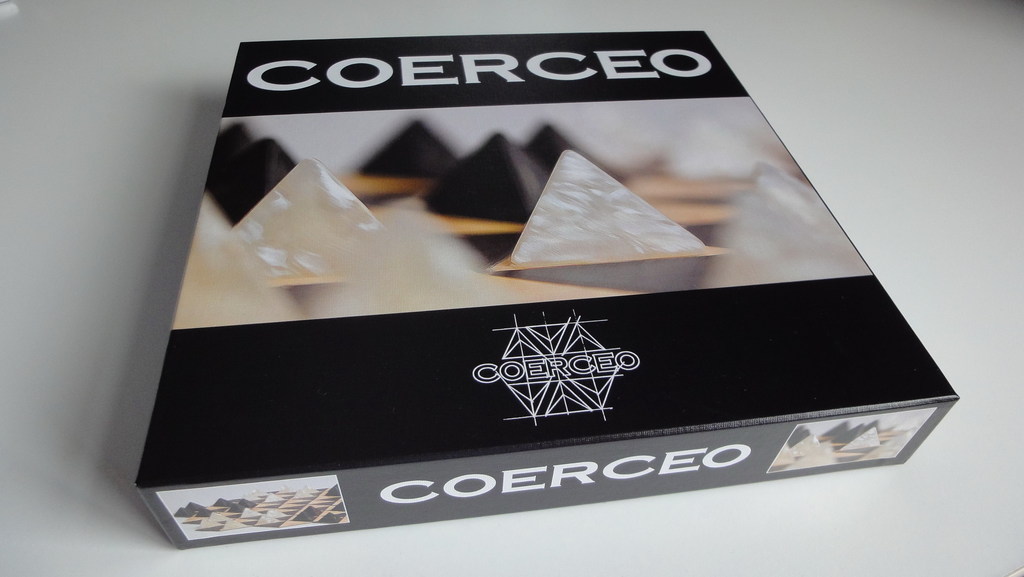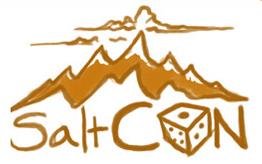Hit the tropics in Tahiti – board game review
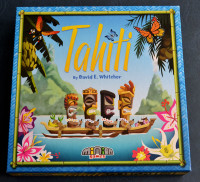
During the cold winter months it’s typical to daydream of visiting tropical islands. And while we may not be able to travel to a tropical island any time we want, at least we can pull out a tropical island board game and mentally escape for a little while.
So let’s take a trip to tropical Tahiti!
The board game Tahiti is a tile-laying game where players set out in their canoes to gather the finest harvest of fruits, vegetables, and spices from the surrounding islands for the tribe.
Players earn glory (victory points) by collecting both variety and quantity of goods over the entire season.
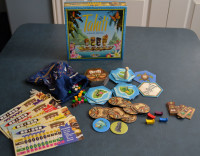
The best gatherer will be named the hero of the tribe.
Tahiti is a fun family game with a good balance of luck and strategy – and of course, also a cool theme.
How to play Tahiti
Set Up:
Setting up Tahiti is simple. There 7 starting tiles placed in the center of the table for every game of Tahiti: the double-sided home island tile, starting island tiles, and water tiles. In a 3-player game, there will be 3 water and 3 island tiles placed around the home island. While in a 2 or 4-player game, there will be 4 island tiles and 2 water tiles to begin.
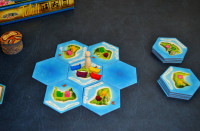
The rest of the tiles are placed face-up into 2 stacks.
The Haumea pawn is placed on the home island. And on each surrounding island is placed 2 cubes – corresponding to the goods indicated on the island. The rest of the cubes are placed in the draw bag. Each player takes a colored canoe and matching colored player board and is dealt a random Favorite Foods tile (which is kept secret).
The player board is where players store their collected goods and is divided into two sections: Canoe display & Harvest chart
The Canoe display has 6 spaces – used for Rowers or Goods. One space is for a permanent Rower and 2 spaces are only used for Goods. The other 3 spots have Rower icons and can be used for either. The number of Rower spots not covered indicates how many actions the player can take.
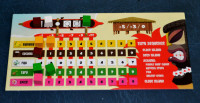
The spaces in the canoe create a dilemma and drive the decisions in the game. Collecting more goods is a good thing (since that’s the objective of the game), but will limit the number of actions you can take on your turn. Sometimes it’s a tough choice how to use the precious spaces.
The Harvest chart is where the goods are stored once a player brings them back to the home island. The different types of goods are stored on the associated colored rows and are worth varying points. The numbers at the top of the chart indicate the bonus points for collecting full sets of goods.
Playing a Round:
The game is played over a series of rounds broken down into 4 phases for each player turn: Exploration, Haumea’s Bounty, Action, and Depletion.
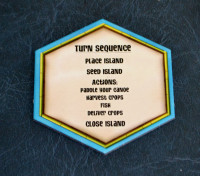
1. In the Exploration phase, the active player first moves the Haumea pawn to a tile at the edge of the board. If the Haumea figure is already on a tile at the edge, it doesn’t have to be moved. This pawn shows the way to fertile land.
The player then takes one of the tiles from the top of the face-up draw stacks and add it to the board. It must be placed next to the tile with the Haumea pawn and adjacent to two already-placed tiles. The player can orient the tile any way they would like.
When the last tile is placed, the Haumea figure is removed and future rounds won’t include the Exploration phase. The end of the game is nearing.
2. In the Haumea’s Bounty phase, the active player draws 3 cubes from the bag and places them on corresponding empty goods spaces on islands not marked with a Depletion token. If there are multiple open goods spaces, the player chooses on which spaces to place the cubes. Any goods cubes that can’t be placed are returned to the bag.
3. In the Action phase, the active player takes the number of actions shown on the Canoe display of their player board. Each Rower not covered allows the player to take one action.
There are 4 possible actions: Paddle their canoe, Harvest goods, Go fishing, or Deliver goods. Players can choose any combination of actions and perform them in any order.
- Paddle: As the name implies, this is how players move their canoe one space (to an adjacent tile). Each time a player paddles over a reef they draw a cube from the bag. If it matches a color cube in that player’s canoe, the good is removed from the canoe and returned to the bag.
- Harvest: Take 1 good from the island the player’s canoe is at and place it in an empty space of their Canoe display.
- Go Fishing: If the player’s canoe is not on the home island they can attempt to catch fish. To do so, the player draws 2 cubes from the bag. If 1 or more is a white (fish) cube, the player may add 1 fish cube to their canoe.
- Deliver: If the player’s canoe is at the Home island, they may unload all the goods from their canoe for a single action. They are placed on that player’s Harvest chart according to color in the left-most empty spot.
Since Rower spots can be covered by collecting a good for an action, if at any time during their turn, the number of Rowers still visible is less than or equal to the total number of actions already taken, the player must stop.
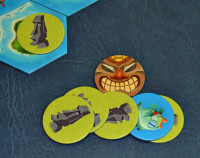
4. The Depletion phase only occurs once the Haumea pawn is removed from the game. During this phase, if there are any islands without goods cubes, the active player chooses one such island, draws a random Depletion token and places it face-up on that island. An island with a Depletion token on it doesn’t produce any goods for the rest of the game.
Some Depletion tokens have a Fish icon on them. When going fishing on these island tiles, the active player draws 3 cubes from the bag instead of the normal 2 cubes.
End of Game:
When there are only 4 island tiles that are not marked with a Depletion token, the growing season comes to an end. Play continues to the end of that round (so that each player has played an equal number of turns).
All players then move any goods still on their canoe display to their Harvest chart. (Players don’t have to be back at the home island or take an action to Deliver such goods.)
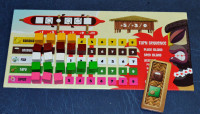
Then players total up their points in these 3 areas:
- For each type of good, players earn the number of points equal to the number in the first empty spot to the right of their cubes on the Harvest chart.
- Any full sets of goods will score points as well. Only include the point value listed at the top of the right-most completed column.
- Players also earn 5 points if they collected the most (compared to other players) of their favorite goods. They earn 3 points if they collected the second most of their favorite goods. In both cases, being tied for most still counts as “most”. Each player has 2 favorite goods, so they can score up to 10 points this way.
The player with the most points wins the game!
What we like about Tahiti
The first thing we like about Tahiti is that it’s a tile-laying game. One of the first board games that pulled our family into the world of modern board games is the tile-laying game Carcassonne.
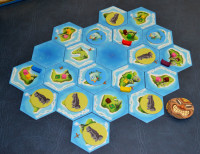
In tile-laying board games the landscape (or in this case, seascape) changes every time you play. The players determine which islands will will pop up where.
In Tahiti this means that players can place the islands with goods they prefer in locations most advantages to themselves. How fortuitous!
Of course, players aren’t always going to draw the tiles they need/want. But that simply adds another element we like about Tahiti – the element of luck.
Players have to work with what they’re dealt – planning and adjusting their strategies and tactics as they play.
Tahiti has a good balance of luck and strategy throughout the game.
We also love the artwork and high quality components. The individual player boards are a great way to store goods and track progress. And knowing how the other players are doing heightens the interest even when it’s not your turn.
The final element we want to mention that adds to the fun is the inclusion of a favorite set of goods. Each player has their own favorite goods that are kept secret from the other players. Players that collect the most of their favorite goods will get extra points at the end of the game.
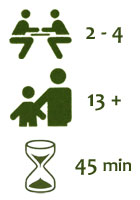 So while most of the points are out in the open during the game, there’s always a chance that the favorite goods collections will deliver a twist in the end.
So while most of the points are out in the open during the game, there’s always a chance that the favorite goods collections will deliver a twist in the end.
Set sail for the tropics
Are you ready to set sail for the tropics?
When you’re stuck inside from snowstorms, it’s the perfect time to play a board game about sailing canoes around tropical islands.
Thanks Minion Games for this fun family board game!

